
Note From Lev:
In January 2010, I published an article in Pumps & Systems predicting the development of the Middle East pumping systems evolution over time. The Middle East presents a great potential for many kinds of technology applications, of which pumping is one of the most natural. Water and energy were, are and will continue to be two of the most basic needs of humanity.
The Middle East has a challenging terrain, with desert and nearly uninhabitable landscapes making it difficult to live in a comfort more available in less severe climate zones. The discovery of oil provided an incredible boom to the rapid rise of modern availability of comforts, making life easier and better. At the same time, European countries are also evolving, requiring additional resources of energy. Thus, a combination of natural resources of oil in the Middle East and a need for such resources by Europe make it a perfect fit to begin cooperation that was not available for centuries. Constructing oil pipelines and supplying Europe with oil can be coupled with additional energy generation from waterfalls based on mountainous terrains—which allows the construction of hydropower stations to generate energy to drive the motors of the oil pipelines.
This, in turn, presents many welcome political changes that have started to shape the Middle East, such as Arab-Israeli cooperation, formally ratified as the Abraham Accord, and many other steps toward peaceful cooperation and gradual normalization in the lives of all people.
I believe even the current conflict in the Middle East between Israelis and Palestinians will be resolved and the otherwise trend toward eventual normalization will continue. And just as my 2010 article might have been an unbelievable dream at that time but is now a reality, some years from now, what seemed to be like an impossible dream will look, in retrospect, as a hopeful foresight of the ultimate triumph in human desire for peace, cooperation and progress.
It is by the effort of the optimists—not pessimists—that progress is made. Believe it, and it will happen. And then, help make it happen. So, please enjoy the reprint of the 2010 article, and imagine the implications it might have for the future. A good, happy future!
January 2010 Pumps & Systems Article:
Massive amounts of energy are used to transfer oil and refined products over long distances. In the United States, several long-distance pipelines move gasoline from the refineries in the Southwest to the coastal areas in the Northeast. Pipelines are an efficient, quick, reliable and economic method compared to trucking or boats.
Colonial Pipeline Company uses banks of large, horizontally split, double suction pumps to transport gasoline over thousands of miles. Booster stations are located approximately 60 miles from one another, with four 5,000 horsepower (hp) booster pumps hooked up in series (Image 1).
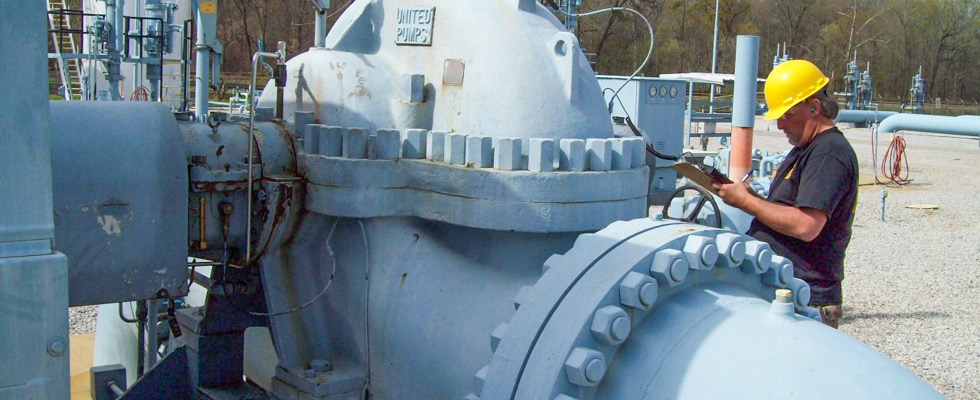
The energy used for such transfer is enormous. At a $0.10/kilowatt-hour (kWh) energy cost, each pump consumes nearly $3.3 million per year. With four such pumps per booster station and approximately 50 booster stations along nearly 3,000 miles of pipeline, the total energy consumed to move gasoline is enormous.
In other areas of the world, fuel and energy transfer over long distances has also proven challenging. Connecting areas deficient in energy resources, like Europe, with the rich oil fields of the Middle East has always been an attractive alternative to ocean tankers. However, the absence of developed infrastructure and deficiency of electricity to power the motors required has been delaying such a project for years. The concept of a pipeline connecting the Middle East with Europe is not new, but the vast distances needed to be spanned, as well as political reluctance, has been an ongoing challenge.
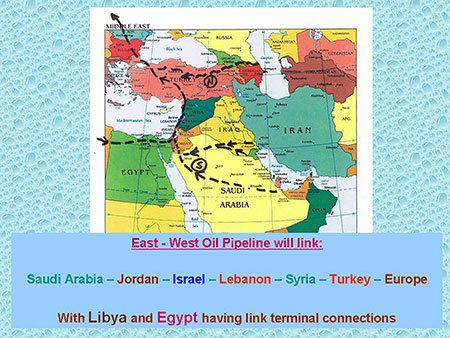
The East-West Intercontinental Oil Pipeline (EWIOP) will require comparable, or even greater, amounts of energy for the pump motors than the U.S. pipeline described above. To move the estimated requirement of 200,000 barrels of oil per hour will require approximately 100 booster stations, with 12 pumps per station and each pump rated at 5,000 hp (3,700 kilowatts [kW]). The total pipeline power demand for these motors is 100 x 12 x 3700 = 4.4 gigawatts (GW) of energy.
A new idea has been proposed to produce the required energy. The idea will also provide an effective solution to another pressing issue in the region—water scarcity. The “Red Sea-Dead Sea Water Conveyance Concept” is a feasibility study and environmental and social assessment financed by the World Bank that has been underway since 2007. Nearly 2,000 million cubic meters of water annually could move along the 400 meter (m) drop from the Red Sea to the Dead Sea. The potential hydraulic power of these 1 million gallons per minute (gpm) at 400 m (1,300 ft) equates to:
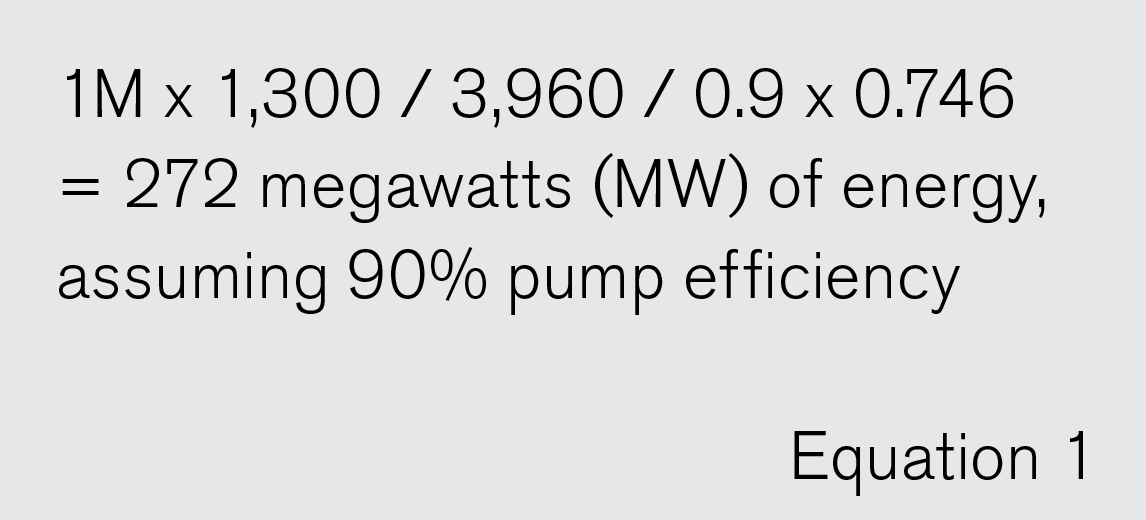
Despite the tremendous power levels involved, the size of the canal (or pipeline) connecting the Red Sea to the Dead Sea is relatively small. With water velocity at an estimated 3 feet per second (ft/s), the area of the canal required can be calculated from the basic formula:
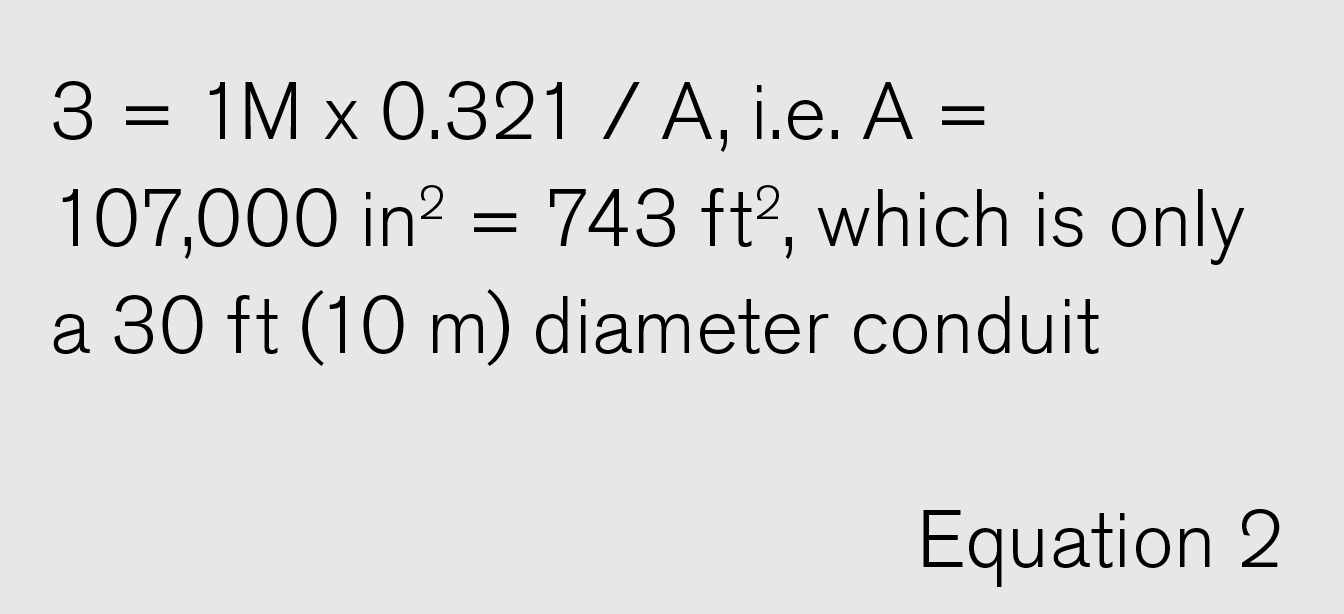
The project, initially conceived as a way to stop the drop in water level in the Dead Sea, has expanded into its present initiative related to the oil pipeline. Current negotiations are now underway in Cyprus and are promising to have a long-reaching positive political development. Present sponsors include France, Greece, Japan, Netherlands, United States and the countries along the EWIOP route.
The tangential benefits of both projects (water and oil) are attractive. Desalination plants, with the recent improvements in efficiency and technology, will consume part of the available energy to provide high pressures for reverse osmosis membrane technology. Roughly 5 GW will cover the needs of the countries in the immediate proximity to the EWIOP pipeline: Saudi Arabia, Jordan, Israel, Lebanon, Syria and Turkey.
Among additional opportunities for “green technologies” is the development of high energy, solar-powered drives for the desalination plants along the route, similar to those described in the March 2009 Pumping Prescriptions column. The hydro power the sea canal uses is non-polluting, environmentally friendly, safe and reliable.
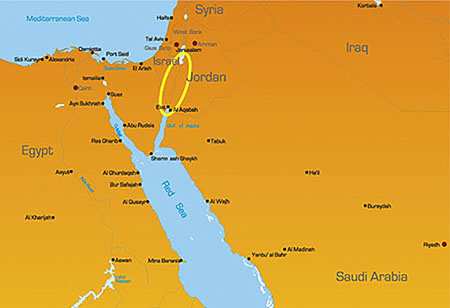
Phase I of the project is estimated to be completed before 2016, with Phase II eventually including Egypt and Libya. Visit worldbank.org for more information.
Additional Notes
At the time of printing, Saudi Arabia and Israel were still open to pursuing normalization discussions. For more information visit: reuters.com/world/middle-east/saudi-arabia-says-there-will-be-no-diplomatic-relations-with-israel-without-an-2024-02-07/.


